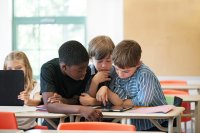Creating Space for Collaboration
Intentionally fostering collaboration in the classroom has a variety of benefits, including increasing students’ level of academic engagement.
Your content has been saved!
Go to My Saved Content.Collaboration and socialization are key aspects of any workplace. Professionals across disciplines and industries collaborate, debate, and share. In the classroom, healthy socialization patterns can support student creativity and foster critical thinking.
Be Intentional With the Classroom Network
A simple change in seating arrangements can promote collaboration and encourage students to talk with each other. Small-group cohesion is important, but teachers must also promote connections beyond the smaller social units in their classrooms.
Recent research shows that when students have more connections with peers in different parts of the classroom social network, they’re likely to show less relational aggression (which includes things like manipulative behavior). Better classroom cohesion correlates with less antisocial behavior and more trust throughout the class.
Form Student Groups
Organizing seating for collaborative learning creates a tricky decision: how to form the student groups. Often, students are eager to choose their own group mates. The problem is that students may struggle to stay productive in groups they chose themselves (not to mention the social stress that may accompany having to pick or be picked for a group). A recent study shows that setting pairings for students can lead them to spend more time on academically relevant discussions and produce higher quality work.
Once you’ve elected to group students, you must decide whether to randomly assign them or create groups based on particular characteristics. First, determine the purpose of the activity. If you want to help struggling students improve their understanding, look for some mixture of ability among students. If a goal of the activity is to target different ability levels to maximize the desirable difficulty for the most students, group students of the same ability levels together.
Once the groups are formed, consider ways to provide structure for different levels of interaction within and between groups. There is value in students developing a rich social network that includes both strong and weak ties. The work students do within their group helps them exchange knowledge and information. While they do this, they also develop trust in each other and a communal group identity.
As teachers, we should remember to give opportunities to also interact with peers outside the group. These interactions can provide new ideas to a group that change their perspective. They can also help create a larger sense of identity and belonging for the classroom as a whole.
Students need meaningful interactions both within their groups and between groups. One method for encouraging collaboration is to assign group roles in a collaborative project and then schedule times for conferences in which representatives from each group who play the same role meet in groups. They can discuss problems and ideas specific to their roles, offering an opportunity for students to collaborate with peers who are not a part of their nuclear group.
Opportunities Outside of Activities
The classroom environment is a valuable tool in relationship building. Research shows that greeting students at the door improves the classroom experience. Try expanding on the concept by giving students structured socialization time. Spending the first few minutes allowing students to greet one another can yield more academically engaged time during class. The structured opportunity to greet peers outside of their primary social circles also improves the strength of the classroom social network.
Because of a phenomenon called social contagion, teacher excitement to get to know students can yield big benefits for just a small time investment. When students believe the teacher cares about the work he or she does and who the students are, they’re more likely to mirror that interest in their classwork.
Support Different Ways of Knowing
The classroom environment is more than the tables and chairs in the room. Teachers can design their rooms to welcome students and promote learning. Beyond the equipment, the interactions also shape our learning environment.
Research shows that music can be an effective classroom tool when used appropriately. If you choose to play music or other sounds in your classroom, be mindful that not every student will react the same way. Some students, especially those who identify as introverts, may find the music distracting.
The best way to ensure that every student is getting what he or she needs in your classroom is to use a variety of techniques, rather than trying to find one strategy that is the perfect fit for everyone. If you’ve managed student groups with music one day, consider allowing students to work in silence during another lesson. You can assess projects by letting students write, draw, sculpt, act, speak, code. For each work product, find ways to display and honor what students have done.
By communicating that everyone’s way of knowing is valuable, you can lay the groundwork for a culture in which students value each other’s contributions as well.
